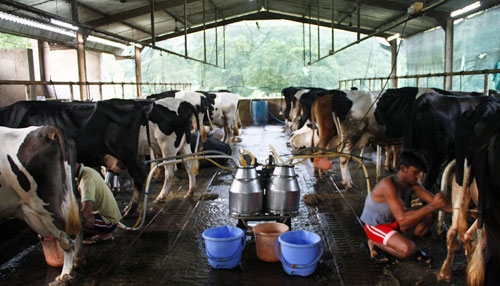Dairy farmers are chickening out of the milk trade

Laxman Malwankar from Naroa is contemplating shutting downhis dairy business. From 15 cows earlier he has now reduced his herd to six. Hegets around 10 to 12 liters of milk everyday. He said, “I do not milk my cowsanymore.” Most of the villagers in Naroa had about five to six cows orbuffaloes. But, walk through the village today and one can only see emptyanimal sheds.
Tulsidas from Bicholim who has five buffaloes said, “Dairy isnot a lucrative option. Manpower is expensive, variety of fodder which isneeded to maintain the animals is not available in Goa. We have to import itfrom other states. Even if we get it, it needs to be kept at a certaintemperature as moisture will destroy it. Goa does not have any facility topreserve the fodder. It is expensive and unviable for a small farmer.”
S D Kulkarni, GM NABARD, Goa chapter spoke of the myriadproblems. “There are no proper chilling and milk collection centers. Even goodanimals breeds are not available. The support price given to the farmers is notenough.”
Madhu Ramakanth from Ponda said, “The precondition to availthe government subsidy is that farmers have to sell their milk to the Goa Dairyat a particular rate. A dairy farmer sells his milk at Rs 17 a litre. The cost of producing 1 litre of milk is Rs20, which results in a loss for us. The farmer has to put additional money fromhis pocket to give milk to Goa Dairy. If there is no profit no one is going totake up the business.”
Goa Dairy director, Madhav Salkar who owns 50 cows rubbishesthese arguments. He said “The prices paid to dairy farmers are the highest inIndia” Goa Dairy claims to pay on an average Rs 22 per liter depending on thefat content.
However diary farmer Madhu from Ponda disagrees. He said, “Weare paid between Rs 17 to Rs 18 per liter. Our expense is 85 per cent more thanthe price we get. How do you expect us to continue being in the business.”
Fed up with this disparity in rates majority farmers areopting out of the dairy business. “The dairy business in the state isrestricted to a few. Political interference in fixing the prices and limitedthinking has led to Goa depending on neighbouring states to fill the milkshortage,” said a top official in the government who refused to be named.
But, Dr Benjamin Braganza, director of department of animalhusbandry agrees that there is lacuna in the system. He said, “We will plug theloopholes. With the new schemes Goa will become self-sufficient in milk in thenext four years.”
In addition recently there was a notification that thegovernment has increased the purchase price from Rs 2.50 to Rs 7.50 per liter.This is expected to take the purchase price of milk from the farmer to Rs 30per litre.
Meanwhile, farmers across the state allege that the dependencyof the Goa Dairy on other states for milk is destroying the business.
While states like Gujarat and Haryana benefited from the milkrevolution, Goa seems to be making no headway.